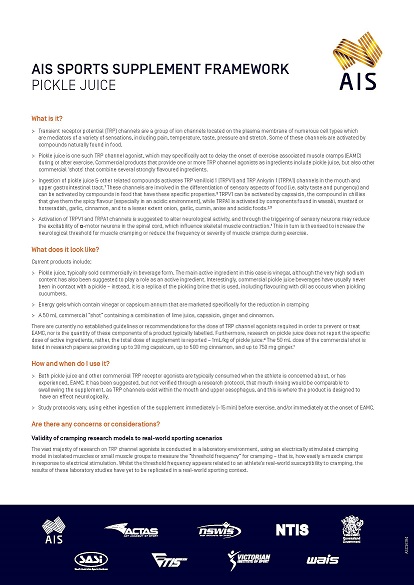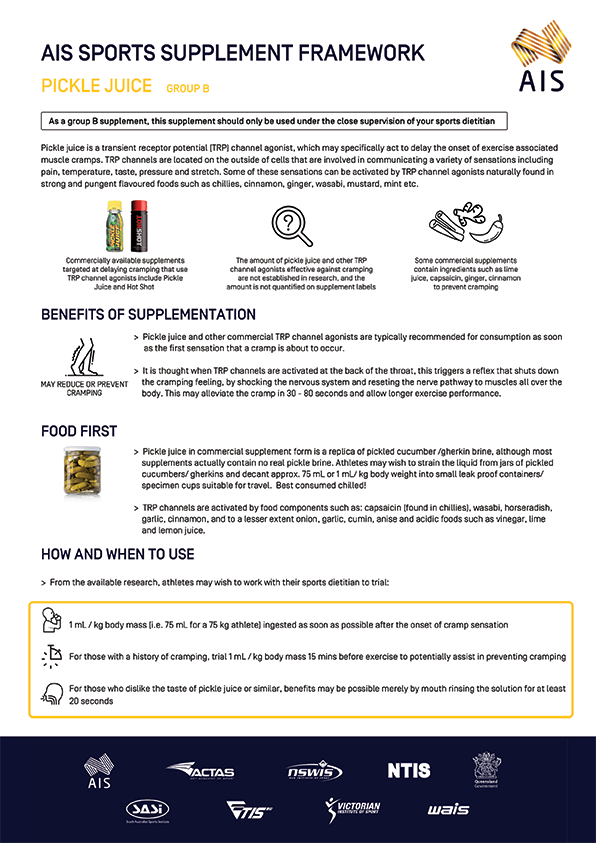Pickle Juice
Pickle Juice
Transient Receptor Potential (TRP) Channel Agonists
TRP channels are a group of ion channels located on the plasma membrane of numerous cell types which are mediators of a variety of sensations, including pain, temperature, taste, pressure and stretch.

36194_Sport-supplement-fact-sheets-Pickle-juice.pdf

Athlete infographics have been developed for the information of athletes under the direct guidance of a sports dietitian. Sports dietitians have expert knowledge of sports supplements and their potential application in an athletes broader health and performance nutrition strategies. Always engage with a sports dietitian when considering the use of any supplement. https://www.sportsdietitians.com.au/#find-sports-dietitian, opens in a new tab
- TRP channels are a group of ion channels located on the plasma membrane of numerous cell types which are mediators of a variety of sensations, including pain, temperature, taste, pressure and stretch. Some of these channels are activated by compounds naturally found in food.
- TRP channel agonists taken as supplements, are a range of products, typically in liquid form, that are designed to prevent or reduce the severity of Exercise Associated Muscle Cramping (EAMC) during or after exercise. Commercial products that provide one or multiple TRP channel agonists as ingredients include pickle juice, and a commercial ‘shot’ that combines lime juice, capsaicin, ginger and cinnamon.
- The active ingredients are food components, that when ingested can activate TRP vanilloid 1 (TRPV1) and TRP Ankyrin 1 (TRPA1) channels in the mouth and upper gastrointestinal tract.1 These channels are involved in the differentiation of sensory aspects of food (i.e. salty taste and pungency) and can be activated by compounds in food that have these specific properties.3 TRPV1 can be activated by capsaicin, the compound in chillies that give them the spicy flavour (especially in an acidic environment), while TRPA1 is activated by components found in wasabi, mustard or horseradish, garlic, cinnamon, and to a lesser extent onion, garlic, cumin, anise and acidic foods.2,3
- Activation of TRPV1 and TRPA1 channels is suggested to alter neurological activity, and through the triggering of sensory neurons may reduce the excitability of α-motor neurons in the spinal cord, which influence skeletal muscle contraction.1 This in turn is theorised to increase the neurological threshold for muscle cramping or reduce the frequency or severity of muscle cramps during exercise.
Current products include:
- Pickle juice, typically sold commercially in beverage form. The main active ingredient in this case is vinegar, although the very high sodium content has also been suggested to play a role as an active ingredient. Interestingly, commercial pickle juice beverages have usually never been in contact with a pickle – instead, it is a replica of the pickling brine that is used, including flavouring with dill as occurs when pickling cucumbers.
- Energy gels which contain vinegar or capsicum annum that are marketed specifically for the reduction in cramping.
- A 50 mL commercial “shot” containing a combination of lime juice, capsaicin, ginger and cinnamon.
There are currently no established guidelines or recommendations for the dose of TRP channel agonists required in order to prevent or treat EAMC, nor is the quantity of these components of a product typically labelled. Furthermore, research on pickle juice does not report the specific dose of active ingredients, rather, the total dose of supplement is reported – 1mL/kg of pickle juice.4 The 50 mL dose of the commercial shot is listed in research papers as providing up to 38 mg capsicum, up to 500 mg cinnamon, and up to 750 mg ginger.1
- Both pickle juice and other commercial TRP receptor agonists are typically consumed when the athlete is concerned about, or has experienced, EAMC. It has been suggested, but not verified through a research protocol, that mouth rinsing would be comparable to swallowing the supplement, as TRP channels exist within the mouth and upper oesophagus, and this is where the product is designed to have an effect neurologically.
- Study protocols vary, using either ingestion of the supplement immediately (~15 min) before exercise, and/or immediately at the onset of EAMC.
Validity of cramping research models to real-world sporting scenarios
The vast majority of research on TRP channel agonists is conducted in a laboratory environment, using an electrically stimulated cramping model in isolated muscles or small muscle groups to measure the “threshold frequency” for cramping – that is, how easily a muscle cramps in response to electrical stimulation. Whilst the threshold frequency appears related to an athlete’s real-world susceptibility to cramping, the results of these laboratory studies have yet to be replicated in a real-world sporting context.
Unnecessary expense and lack of scientific consensus on prescription
There is currently no consensus on the optimal dose of TRP channel agonists, whether some (e.g. vinegar) are more effective than others (e.g. cinnamon), whether combining multiple TRP channel agonists provides an additive or synergistic effect, the optimal timing of ingestion, and whether mouth rinsing is equivalent to swallowing the supplement.
Tolerance of extremely pungent flavours
TRP channel agonists are, by their very nature, strong and pungent flavours, which may be particularly overwhelming during exercise in hot environments. Athletes are strongly advised to always try these products in training that simulates race conditions (i.e. exercise intensity and climate as similar as possible) before attempting to use them in a race scenario.
Gastrointestinal disturbance from ingestion of highly concentration sodium solutions
Pickle juice products in particular are extremely high in sodium, increasing the risk of gastrointestinal discomfort, nausea and/or vomiting. However, research suggests that in the small quantities consumed (~50-80 mL, or around 500-900 mg sodium at a time), there is unlikely to be any observable change in plasma sodium or osmolality5, or gastrointestinal symptoms.
Lack of understanding on the causes of EAMC and thus most appropriate interventions
Exercise Associated Muscle Cramping is poorly understood due to the difficult nature of studying the phenomenon. However, current consensus suggests that EAMC is likely a syndrome, with multiple and diverse risk factors increasing an individual’s susceptibility to cramping6, which is the ultimate outcome. Unlike other syndromes that occur in athletes (e.g. exercise induced gastrointestinal syndrome), currently there is no clear mechanistic pathway to explain the link from risk factors to cramping outcomes, and therefore treatments are generally not targeted towards a specific causal pathway. Because of this, it is not known if TRP channel agonists will be effective for all athletes who experience EAMC, or whether it is only useful in athletes whose cramping has a more specific causal pathway.
Gatorade Sport Science Institute www.gssiweb.org/docs/default-source/sse-docs/maughan_sse_200_final.pdf?sfvrsn=2, opens in a new tab
Supplement safety information and batch tested product list www.sportintegrity.gov.au/what-we-do/anti-doping/supplements-sport, opens in a new tab
- Craighead DH et al. (2017). Ingestion of TRP channel agonists attenuates exercise-induced muscle cramps. Muscle Nerve, 56(3), 379–385.
- Legrand C et al. (2010). New natural agonists of the transient receptor potential Ankyrin 1 (TRPA1) channel. Sci Rep, 10(1), 11238.
- Roper SD. (2014). TRPs in Taste and Chemesthesis. Handb Exp Pharmacol, 223, 827–871.
- Miller KC et al. (2009). Reflex Inhibition of Electrically Induced Muscle Cramps in Hypohydrated Humans. Med Sci Sports Exer. 2009; 42(5):953-961.
- Miller KC et al. (2009). Electrolyte and Plasma Changes After Ingestion of Pickle Juice, Water, and a Common Carbohydrate-Electrolyte Solution. J Athl Train, 44(5), 454–461.
- Maughan RJ & Shirreffs SM. (2019). Muscle Cramping During Exercise: Causes, Solutions, and Questions Remaining. Sports Med, 49(Suppl 2), 115-124.